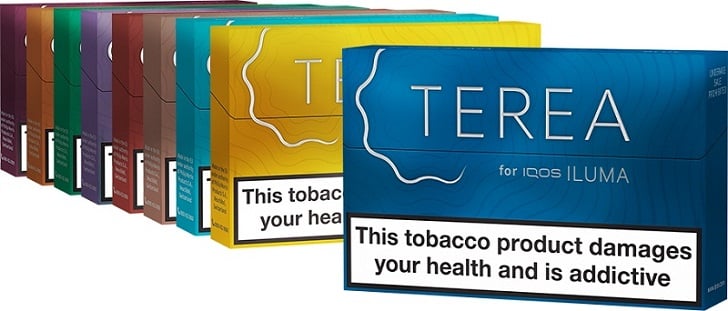
The explosive growth of heat-not-burn products in Japan and Korea, which has taken a huge chunk out of the market for traditional cigarettes, has everyone wondering where else we might see that happen. No one knows the answer for sure, of course, but there are a few patterns that seem fairly safe to predict.
Modeling work I did about the uptake of e-cigarettes a few years ago (example) suggests that the uptake of a low-risk tobacco product will have two distinct periods of rapid growth. The first is caused by pent-up demand. Before the product was introduced, there were people who wanted it, though they did not know this yet, of course. As soon as it was introduced, and knowledge about it became widespread, they started buying it. This causes an initial uptick in consumption rather than steady growth along the lines of “X new consumers per week, every week, for a year.”
Of course, that increase might not stick. Japan Tobacco introduced an alternative product, Zero Style Mint, in 2010 which was superficially like an e-cigarette or heat-not-burn device. However it basically just consisted of inhaling room-temperature air through a tube past some processed tobacco. This delivered neither enough nicotine nor a sufficiently smoking-like experience to be appealing to smokers. Sales spiked (pent-up demand for an alternative to smoking) and then crashed (almost no one actually liked it). Heat-not-burn has cleared that hurdle. Lots of smokers in Japan and elsewhere really like it.
The perfect low-risk substitute for many smokers would be something that was exactly like a cigarette in all ways (aesthetics, appearance and other factors that contribute to cultural acceptability, delivery of nicotine and other psychoactive chemicals, price) except that it posed little health risk, and as a possible added bonus did not make such a mess. Heat-not-burn checks most of those boxes.
Of course some smokers actively embrace contrasts with cigarettes, such as the variety of flavors available for e-cigarettes. Some are not be willing to accept any variation on their beloved cigarettes in pursuit of lower risk. But for many, heat-not-burn is close enough (in terms of what they want) and enough lower risk to make that worthwhile.
After the initial spike and after the acceptability hurdle is cleared, we can expect a period of slower growth until a particular critical mass of consumers is reached. My modeling was built around the assumption (correct, I still believe) that the “cultural acceptability” hurdle is one of the largest. Someone’s culture, in this case, is a combination of the people who influence him the most (relatives, friends, patrons of the same pubs) and overall popularity in whatever he considers “his” population to be (everyone in the country, people in the region, people in his socioeconomic class). If someone has no friends who use a product and only a tiny portion of the population does, it takes greater determination and confidence for him to make a switch, and he might not even know about the product. If the new product seems just as normal as regular smoking in his culture, acceptability and knowledge are no longer barriers.
My modeling suggested that for almost any parameterization (i.e., input assumptions about the distribution of preferences and how people interact) there would come a point when slow growth hit a critical mass. The next few people who switched would be enough to raise the cultural acceptability enough to ensure that even more people quickly switched, and so on. This would feed-forward, creating a rapid rise until most of those who have not switched really do not want to.
I did this in the context of e-cigarettes, which had a rather larger cultural acceptability and knowledge hurdle than heat-not-burn. The better early generation products were sufficiently strange and challenging that the pent-up demand spike was modest. The easiest cigarette-like product were not very satisfying, so suffered the Zero Style Mint problem. For almost all smokers, this was not the alternative they were looking for, but just did not have yet. The second phase of growth in those models was much greater, as it seemed to be in real-life where vaping really took hold (particularly England).
Heat-not-burn will probably not play out the same way. The first growth phase ought to be a lot bigger for reasons already noted. That, however, means that it will comprise a larger portion of the total potential market, reducing the potential size of the second fast growth phase before everyone who is a good candidate for switching has switched.
So, how many is that? And what happens after the second period of rapid growth? Will it be indefinite continuing inroads into the smoking market, or a hard ceiling?
That depends. Indeed, that is the answer to every other quantitative question you might be asking here (e.g., How big is each period of high growth? How long between the various phases?) Unfortunately, to answer any of those requires having great precision in model inputs. It is fairly clear that those modeling the market for heat-not-burn have no idea, as evidenced by the irrational spike in PMI’s market capitalization due to the iQOS’s early success in Japan, followed by a crash when investors discovered that the initial growth phase does not continue forever (a bit more about that here).
Switching patterns can vary wildly. For example, it took decades before smokers Norway, which shares a great deal of cultural influence with Sweden, started to switch to snus in droves. Why the delay? Snus has been popular and mainstream in Sweden for almost half a century and has long been more popular than smoking. But Norway only saw a major shift a few years ago. Meanwhile, Finland and Denmark, where the influence might acted sooner, were hobbled by the European Union ban on snus (Sweden has an exemption and Norway is not in the EU), which is one of a whole different set of policy variables.
Still, it seems safe to draw a few conclusions. Japan was probably the best-case-scenario for pent-up demand for heat-not-burn. Smoking is popular among relatively well-educated and well-off people who are strong candidates for switching. Adding a bit of tech gadgetry to a stick is not exactly going to be seen as odd in such a tech-forward population. Meanwhile, e-cigarettes are banned and snus was always a cultural non-starter. In a population where e-cigarettes have already grown in popularity there is less pent-up demand. Some vapers might switch, of course, but most have settled in to what they do. Thus, we will probably not see as bit an initial growth phase for heat-not-burn sales in new markets.
However, it seems likely that there is a much higher ceiling for uptake compared to e-cigarettes, because heat-not-burn better checks all of the boxes. This is not based on any modeling, but rather is the type of observation that is needed as an input into the modeling. It is possible that a large fraction of smokers in some countries could switch over the course of five or ten years.
However, both heat-not-burn and e-cigarettes fail to check one of the boxes in most of the world: These tech products are only price competitive because of the high prices for cigarettes in rich countries (which include high taxes, which have usually been lower for low-risk products in markets where they took off). Cigarettes are a simple product whose price reflects the local cost-of-living like food prices do, and the same is true for smokeless tobacco. But high tech imports will have prices that reflect their higher real resource costs and the higher costs of doing business where they are made. Thus, the idea of migrating more than a small fraction of the world’s smokers to heat-not-burn seems like fantasy for the foreseeable future.











